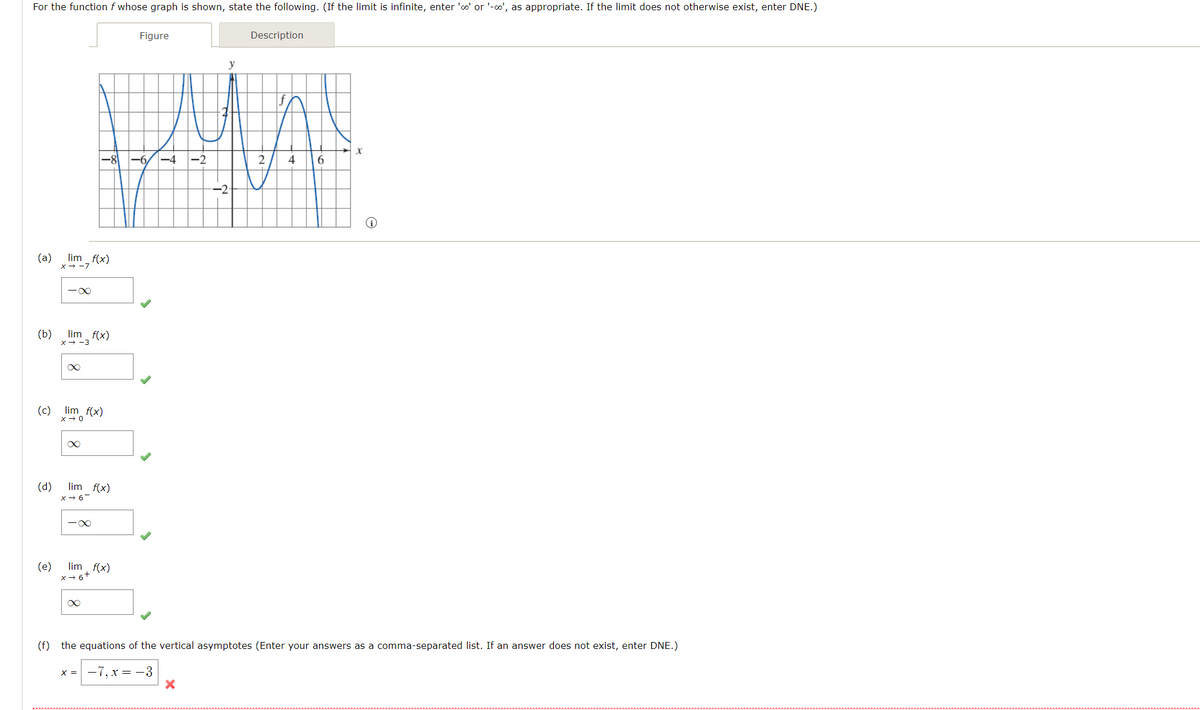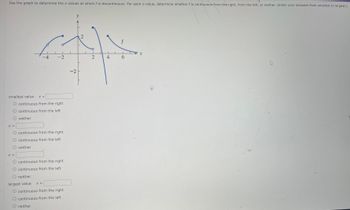For the function f whose graph is shown, state the following. (If the limit is infinite, enter 'o' or '-co', as appropriate. If the limit does not otherwise exist, enter DNE.) Figure Description -6/-4 6 (a) lim f(x) -00 (b) lim f(x) (c) lim f(x) (d) lim f(x) x- 6 -00 (e) lim f(x) x+ 6* (f) the equations of the vertical asymptotes (Enter your answers as a comma-separated list. If an answer does not exist, enter DNE.) -7, x = -3 X3D
For the function f whose graph is shown, state the following. (If the limit is infinite, enter 'o' or '-co', as appropriate. If the limit does not otherwise exist, enter DNE.) Figure Description -6/-4 6 (a) lim f(x) -00 (b) lim f(x) (c) lim f(x) (d) lim f(x) x- 6 -00 (e) lim f(x) x+ 6* (f) the equations of the vertical asymptotes (Enter your answers as a comma-separated list. If an answer does not exist, enter DNE.) -7, x = -3 X3D
Calculus: Early Transcendentals
8th Edition
ISBN:9781285741550
Author:James Stewart
Publisher:James Stewart
Chapter1: Functions And Models
Section: Chapter Questions
Problem 1RCC: (a) What is a function? What are its domain and range? (b) What is the graph of a function? (c) How...
Related questions
Question
100%

Transcribed Image Text:For the function f whose graph is shown, state the following. (If the limit is infinite, enter 'oo' or '-', as appropriate. If the limit does not otherwise exist, enter DNE.)
Figure
Description
-6,
-4
4
6
(a)
x", f(x)
lim
-7
(b)
lim f(x)
x- -3
(c) lim f(x)
(d)
lim f(x)
lim, f(x)
(e)
x + 6+
(f) the equations of the vertical asymptotes (Enter your answers as a comma-separated list. If an answer does not exist, enter DNE.)
x = -7, x =-3
Expert Solution
This question has been solved!
Explore an expertly crafted, step-by-step solution for a thorough understanding of key concepts.
This is a popular solution!
Trending now
This is a popular solution!
Step by step
Solved in 2 steps with 2 images

Follow-up Questions
Read through expert solutions to related follow-up questions below.
Follow-up Question
Can you help me answer this question?

Transcribed Image Text:Use the graph to determine the x-values at which f is discontinuous. For each x-value, determine whether f is continuous from the right, from the left, or neither. (Enter your answers from smallest to largest.)
X =
smallest value x =
O continuous from the right
O continuous from the left
O neither
X =
-4
O continuous from the right
O continuous from the left
O neither
-2
O neither
largest value
continuous from the right
O continuous from the left
X =
continuous from the right
O continuous from the left
neither
y
-2
2
2
4
6
X
K
Solution
Recommended textbooks for you

Calculus: Early Transcendentals
Calculus
ISBN:
9781285741550
Author:
James Stewart
Publisher:
Cengage Learning

Thomas' Calculus (14th Edition)
Calculus
ISBN:
9780134438986
Author:
Joel R. Hass, Christopher E. Heil, Maurice D. Weir
Publisher:
PEARSON

Calculus: Early Transcendentals (3rd Edition)
Calculus
ISBN:
9780134763644
Author:
William L. Briggs, Lyle Cochran, Bernard Gillett, Eric Schulz
Publisher:
PEARSON

Calculus: Early Transcendentals
Calculus
ISBN:
9781285741550
Author:
James Stewart
Publisher:
Cengage Learning

Thomas' Calculus (14th Edition)
Calculus
ISBN:
9780134438986
Author:
Joel R. Hass, Christopher E. Heil, Maurice D. Weir
Publisher:
PEARSON

Calculus: Early Transcendentals (3rd Edition)
Calculus
ISBN:
9780134763644
Author:
William L. Briggs, Lyle Cochran, Bernard Gillett, Eric Schulz
Publisher:
PEARSON

Calculus: Early Transcendentals
Calculus
ISBN:
9781319050740
Author:
Jon Rogawski, Colin Adams, Robert Franzosa
Publisher:
W. H. Freeman


Calculus: Early Transcendental Functions
Calculus
ISBN:
9781337552516
Author:
Ron Larson, Bruce H. Edwards
Publisher:
Cengage Learning